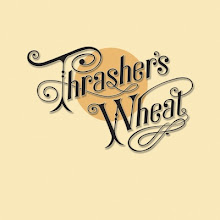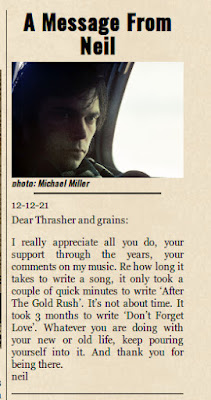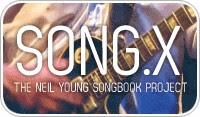Meta Review: A Treasure - Neil Young & The International Harvesters

Neil Young & The International Harvesters
The reviews for Neil Young & The International Harvesters' new album "A Treasure" have been rolling in like diamonds in the dew.
As for our take on all this, we'll just say that "A Treasure" was released as a tribute to the late, great Ben Keith. There's really not much more to add to that...
So, are you ready for the country? If so, here's a meta review round up...
From Neil Young Unearths His Country 'Treasure' | Rolling Stone Music | Alternate Take by David Fricke:
A stand-alone triumph and vital to understanding his creative impulses at one of the toughest junctures of his career.
From FILTER Magazine by Daniel Kohn:
Though these performances are more Willie Nelson and less Crazy Horse, that doesn’t take away from the grizzled vet’s willingness to take chances. The music hasn’t changed, but times have—and for that, the bard deserves an apology from the legions of doubters who thought he lost his marbles because, as this live record confirms, the man truly remains ahead of the curve.
"Amber Jean"
From SoundSpike by Kurt Hegre:
Neil Young is too weird to be a good redneck.
Oh, sure, he wore a bandana, played Hank Williams' guitar and threw his support behind Ronald Reagan in the '80s, but at the end of the day he's still just an eccentric, hippie genius who doesn't belong in Nashville any more than he does at a royal wedding.
The man can play country music as well as anyone alive, but it's when he turns up the volume on his latest release that we really get a taste of what sets him apart from all the fake country music that fills arenas across the country.

From Turn It Up by Greg Kot:
Young’s ongoing series of archival releases allows him to have the last word, or at least to frame what he was doing in a clearer context. “A Treasure” (Reprise) documents his country phase and makes the point that, no matter what his detractors and doubters say, it really wasn’t a “phase” at all, but one of his periodic and most fully realized immersions into the genre. The dozen tracks are drawn from a 1984-85 tour with an excellent eight-piece band he dubbed the International Harvesters. It included longtime collaborator Ben Keith, as well as such stellar Nashville instrumentalists as Rufus Thibodeaux, Spooner Oldham and Hargus “Pig” Robbins.
The set includes five previously unreleased Young songs, all of which present credible takes on Nashville traditions: the way cornball humor masks a broken heart in “Let Your Fingers Do the Walking,” the outlaw swagger of “Soul of a Woman,” the sweet celebration of a newborn daughter in “Amber Jean,” the hard-won spiritual wisdom of “Nothing is Perfect,” and the stomping, howling “Grey Riders” – a new, old classic.
What makes this album a must for Young aficionados is that the Harvesters are likely the most musically accomplished band the singer ever assembled. Thibodeaux’s fiddle and Keith’s steel-guitar complement Young’s craggy guitar; there’s an evident virtuosity, but it never comes off as slick. This band could light up any honky-tonk on a Saturday night.
"Get Back To The Country"
From PopMatters by Matthew Fiander:
So Young seems to get it both ways on A Treasure.
We see a rough-hewn country side, but he doesn’t neglect his ability to crunch out some rockers. The unreleased material here — particularly closer “Grey Riders” with its thundering solos — prove worthy editions to the Young canon, and are palatable enough for both long-time fans and anyone who might just stumble upon these tunes.
A Treasure shows us a curious side to Young as a performer, and confirms his unpredictable artistic vision, but its biggest feat is salvaging solid songs from subpar albums. Of course, the trouble with that is — while the songs are exponentially better here — they still don’t always represent the best of Young’s songwriting. While this may not sound like Old Ways, what it shares with that record is that this set has a solid overall sound, but the songs themselves don’t always distinguish themselves.
Young’s singing is brittle and sweet here, and the players vital, but if you weren’t told it was Neil Young you might mistake some moments for the musings of an anonymous bar band. While in some ways that speaks to the loose and joyful feel of these recordings — despite the trouble around him, Young sounds for all the world like a carefree singer — it undersells Young’s distinctive voice both as a singer and songwriter. Like many of his more divisive albums, A Treasure finds him digging into a musical itch he needs to scratch—here, the country and western tradition—and while it works better than those records, it still might be more of a compelling and curious piece to the Neil Young story than it is a great live document in its own right.

Ebet Roberts/Redferns/Getty
From Consequence of Sound by Jake Cohen:
The nearly eight-minute “Southern Pacific”–a chugging lament on train culture–is the centerpiece of the second half of the album. The train screams into your headphones with a fast rock backbeat and lyrics full of melancholy and nostalgia. Anthony Crawford’s totally raw banjo solo, complete with noisy fret scratching, sounds like the sound of rusty train brakes. Young’s voice soars with urgency, delivering a commanding performance of this socially conscious tune, channeling the plight of the American worker into song.
Yes, it’s a live album, but not “this is what he’s been doing recently.” If anything, this feels more like a vault release of a new band with familiar faces. Above all, you can feel the exuberance that comes from playing raw, unbridled live music, and there are few from that generation who excel at this better than Neil Young. Old man, take a look at your life, indeed.

Photo by Steve Cross
From Premier Guitar Joe Coffey:
A Treasure is a 12-song time capsule of that tour and includes five unreleased tracks that Young fans have been wondering about for 25 years. It’s being offered in the standard mp3 and CD formats, as well as a CD/Blu-ray package that aims to give fans an offering in the audio connoisseur-preferred Blu-ray format, even though no known video exists to give viewers moving visuals of some of the performances. Blu-ray viewers see the album cover on the screen during much of the album. Since something is better than nothing, existing video of Neil performing some of the songs is synced up with the audio on the Blu-ray, even though a few different musicians rotated in and out of the International Harvesters and this video may not accurately show who can be heard playing, if that makes sense.
This is a welcome concession for Young fans that relish a Blu-ray listening experience. But it’s a bit ironic since the mix, which isn’t bad at all, is still limited by the quality of the source recordings. In a video on his website, Young admits, “we didn’t use good sound in the first place,” while emphasizing that the recordings are “… the best versions of these songs.”
With that in mind, listeners can approach the album with a new-old-stock kind of expectation, which is appropriate considering the contents. Standout Ben Keith, the late steel player who can be heard on Patsy Cline’s “I Fall to Pieces,” as well as Young’s original version of “Old Man,” adds rich textures of lap and pedal steel throughout the album. His country-western (as they used to call it) authenticity is matched by Rufus Thibodeaux’s fiddle. Right out of the gate, the two set the mood for the album on the opening track, “Amber Jean”— a Texas two-step number recorded when Young and the band appeared on the Nashville Now TV show with Ralph Emery. Other standouts include the honky tonk-infused “Let Your Fingers Do the Walking,” a bluegrass-meets-rock version of “Get Back to the Country,” and a locomotive-strong performance of “Southern Pacific.”
Neil Young -"Southern Pacific" from A Treasure
From LAist By Bobzilla:
The eighties were a big decade for midlife crises (and lawsuits) among sixties rockers, but Young took the desire to mutate with the times and head into unpredictable territory much further than any of his peers.
In response to the pressure, Young split town, fired his Hollywood booking agent, and headed to Nashville. There he found himself a hell of a support crew, built around pedal steel player Ben Keith and fiddler Rufus Thibodeaux, and hooked up with Waylon Jennings’ agent, who put the band on the state fair circuit. By all accounts, the change of venue suited Young just fine. One of the tracks on A Treasure was recorded at Gilley’s Rodeo Arena in Pasadena, TX, a show at which Young was reported to have surveyed the rickety wooden stage, suspended ten feet in the air over a massive pile of horse shit, and marvelled, “Sure beats playin’ to a bunch of fuckin’ hippies at the Fillmore!” Young stuck with it and toured the group for a solid year, longer than any of his other genre diversions, though a followup to the 1984 album Old Ways never materialized.
At the center of this release are live versions of five previously unreleased songs that surfaced on his 1984 and 1985 tours. “Grey Riders” is the instant classic of the bunch, a frantic gallop with a killer guitar breakdown that would have fit perfectly on Time Fades Away. Placed at the end of the album, it’s shocking the first time you hear Young’s guitar explode and become the loudest thing in the room, obliterating his band, like he’s been holding that back for an hour and it’s time to let it out.

From Crawdaddy! by Jeff Wilson:
But there’s more than just high quality musicianship involved in A Treasure, which is culled from shows Young and the International Harvesters performed during a US tour in 1984 and 1985. A good chunk of Neil Young’s work conjures up images of a hippie that lives out in the desert in hopes avoiding the madding crowd, but A Treasure reflects engagement. Economically, America was hemorrhaging and people were hurting, and many of these songs address that pain. To put it lightly, decades later the concerns expressed in these songs still seem relevant.
Although the emphasis during the International Harvesters tour was on traditional country and western music, some of the best moments occur when Young leads his bandmates down some unfamiliar paths. Although it’s more reminiscent of the Beach Boys than Hank Williams, the dreamy Buffalo Springfield classic “Flying on the Ground Is Wrong” is so strong here that I question whether any version can top it. Sounding like a hellbound train barreling down the tracks on a stormy night, the haunting “Southern Pacific” features some brilliant banjo, steel guitar, and fiddle.

Photo by Chuck "iused2BAfireman" Naughton
From Uncut.co.uk by Damien Love:
This being Neil Young, it only makes sense he should follow his most haunted and out-there record in years, 2010’s Le Noise, with one of the easiest, most carefree and down-home releases of his career.
You could argue there’s simply not much that really needs be said about this, the latest in Young’s Archives Performance Series – a live compilation drawn from his 1984-’85 tours through the heartland of Reagan’s America with the band of country veterans. For the most, this is music to be felt more than thought. Good simple songs about good simple things, to tap a toe to, drink a beer to, wipe away a tear to.
On the other hand, though, when you step back and consider the context, A Treasure becomes more than just a collection of countrified tunes delivered with gloriously ragged enthusiasm. This album is the sound Neil Young makes when you push him.
...
Warts, ugly cousins, blazes of greatness and all, however, A Treasure makes a perfect snapshot of this ornery, shapeshifting moment. Certainly, there’s no arguing with the other unreleased song, “Grey Riders”, a spooked, weird run through “Ghost Riders In The Sky” territory, cannily sequenced as the closing track, and not merely because the Harvesters shift to a new pitch of intensity. Here, as though he can hold it back no longer, Young’s guitar begins wrenching loose in mangled, restless, rusty squeals. You could call it the “classic Neil Young” sound, if there was such a thing. But as the howl comes slicing through, it sends out a clear signal. Things were about to change. Again.
From Jambands.com by Brian Robbins:
I know I promised a descriptive phrase for the sounds to be found on A Treasure. I toyed with “grungebilly” and jotted down “Cosmic Hank”. Neither really does these tunes justice, however. The music made by Neil Young and that once-in-a-lifetime lineup known as the International Harvesters was what it was. And it was theirs. And it was great.
God bless Ben Keith: it was he who – when he first put an ear to these recordings – referred to this music as “a treasure.”
Right on, Ben. You said it better than I ever could.

Bridge Benefit Concert 2008
Photo by Craig Abaya
More on A Treasure: New Neil Young Album Coming and Release Details on A Treasure: New Neil Young Album Coming June 14.
Also, see Neil Young News: Neil Young Discusses The International Harvesters and "A Treasure" Release and Tech Notes on The Making of A Treasure.

International Harvesters Tour, Costa Mesa, CA - 10/24/84
Photo by Robert Matheu































 Human Highway
Human Highway

















 Concert Review of the Moment
Concert Review of the Moment





 This Land is My Land
This Land is My Land

 FREEDOM In A New Year
FREEDOM In A New Year









 *Thanks Neil!*
*Thanks Neil!*




![[EFC Blue Ribbon - Free Speech Online]](http://www.thrasherswheat.org/gifs/free-speech.gif)











 The Unbearable Lightness of Being Neil Young
The Unbearable Lightness of Being Neil Young Pardon My Heart
Pardon My Heart



 "We're The Ones
"We're The Ones  Thanks for Supporting Thrasher's Wheat!
Thanks for Supporting Thrasher's Wheat!




 This blog
This blog 
 (... he didn't kill himself either...)
#AaronDidntKillHimself
(... he didn't kill himself either...)
#AaronDidntKillHimself









































































 Neil Young's Moon Songs
Neil Young's Moon Songs




 Civic Duty Is Not Terrorism
Civic Duty Is Not Terrorism Orwell (and Grandpa) Was Right
Orwell (and Grandpa) Was Right


 What's So Funny About
What's So Funny About 



14 Comments:
I haven't gotten real excited about this one for some reason.I dunno.I was there at Gilley's when Neil played that night so I remember the musuc..it just didn't excite me too much.After reading ALL these reviews I'm chomping at the bit to go get this one!!!To listen with "fresh ears" if you will.. thanks again Thrashman....
And here's another one:
http://www.rollingstone.com/music/blogs/alternate-take/neil-young-unearths-his-country-treasure-20110614
"The man can play country music as well as anyone alive, but it's when he turns up the volume on his latest release that we really get a taste of what sets him apart from all the fake country music that fills arenas across the country."
Nice.
"At that point in my life, the people in control of who played the music on the radio, how it got out, were sure that I shouldn't be doing what I was doing," Young says with a curt lingering irritation. "But it didn't matter to me. I kept on doing it anyway. When you hear this record, that's the reason. Maybe now, 25 years later, it might float.
"But the thing is," he adds, "it doesn't matter if it floats. Because it floats for me and the musicians, for everybody that was a part of it."
Nice too.
*A Treasure* would have worked really well on vinyl, as the first six songs (which would have been side 1) all hang together, while the last six, which also hang together, strike a very different chord. On vinyl, this would have given the same contrasting-sides impression as *Rust Never Sleeps*. One wonders whether Neil thought about this as a vinyl record when he decided on the order of the tracks.
"Side one" is really tame stuff. It's all good, but it all could have been played on Hee Haw, which is to say that it's musically "safe". "Side two", on the other hand, reminds us, on every track, that we're listening to a genius, who approaches the guitar the way Thelonious Monk approaches the piano.
JCP
Ummm...hello anonymous...'A Treasure' IS available on vinyl...hello?
Jonathan,
I figured it was.
You miss my point, which is that the order of the tracks seems to reflect the mindset of producing for vinyl rather than of producing for the CD.
JCP
Whatcha think of that engraving on Side 4 of the vinyl edition?
Worthy of framing, IMHO.
JCP: the track listing is chronological. That is the mindset.
-Archives Guy
Hi Archives Guy: Yes, the vinyl is very cool. A nice surprise on side 4.
Just posted photo in review.
Wonder why only one side got the special treatment? Suppose it is an expensive bonus and prohibitive for 4 sides?
Anyways, really enjoying seeing & hearing that old country fiddler..
The Bluray is cool with fan shot video. Sounds like we may see more of that style coming with NYA 2 maybe?!
Ben Keith got it right.
A Treasure is a treasure.
I've been working on breaking this one in. There's no doubt about it, musicians like Pig Robbins, Rufus T. ,and the much-missed Long Grain were/are tremendously talented, and these raw takes show their virtuosity in all its ragged glory. I especially like how Neil inventively works fiddle and banjo into some of the arrangements. Southern Pacific will probably be revisited many times for Thibideaux's fiddle flourishes alone. I also noticed some nice touches of mandolin here and there; trust Neil to work in these truly refreshing departures from the norm.
The opener, Amber Jean, is a poignant favorite for me--a really beautiful statement we should try to make, through our actions, for ourselves and each other. It's that kind of hope, however seemingly simplistic and naive, that I feel may be the first step in creating happy lives.
Personally, this is overall a three or four star album for my taste. I'll post more thoughts later as I feel inspired, but for now, I'm just making sure everyone knows that D. I. hasn't departed the face of the earth.
DI - Thanks for comment.
Yes, AJ is quite special ... from the heart if ever there was such a song.
Good to hear from you. Don't be a stranger... ;)
Datsun/Toyota/Nissan
My army jeep is still alive
It's got locking hubs
And four wheel drive
Ain't got no radio
Ain't got no mag wheel
Ain't got no digital clock
Ain't got no clock
My paint job is baby blue
My levi's are shrinking too
But I guess until I get my job back
This will do
Thanks for the recognition, Thrash.
Up front let me admit that country Neil, and I mean hardcore country Neil, isn't my favorite incarnation. 'Old Ways' remains one of my least-played Neil Young albums.. That said, I do often enjoy the sound of country *music*; it's the lyrics that bother me, more often than not. That's why 'Nothing is Perfect' is my least favorite track here. It has all the lyrical subtlety of a jackhammer, which is a bit odd coming from Neil--especially on a religiously related theme. The only thing I really enjoy about that one is how Neil redefines what it means to "stand by your man." The rest of it I feel I could get by inviting myself to dinner at a southern Baptist pastor's house. Sorry, I'm a Northern Man. I really have nothing against Mr. Christ. It's some of the Christians I find stifling and frustrating.
'Let Your Fingers do the Walking' is mostly whimsical good fun. However, the opening verse leaves a somewhat sour taste in my mouth: 'Back in the days of covered wagons/a man had his way/whether talkin' to a woman/ or crossing the USA." I know, given his sentiments expressed in other songs--including some here--that Neil almost certainly doesn't mean anything by this, and it may just be that he embraced the undercurrent of misogyny I detect as part of the genre exercise, but the whole '19th century cowboy' mentality still holds back some of this stuff for me. I guess I'm just not a good old boy.
'Bound for Glory', though, is a great track I never appreciated before. The chords and story are totally Neil, in spite of the heavy country arrangement. I found this song, for lack of a better word, a revelation. I particularly like the line, "fireflies buzzing around her head, like candles in the fog". The story, moreover, is just what I like to hear: two people discovering themselves and their world, going against conventional values to find the right thing.
'Motor City' fit in better with the boneheaded Crazy Horse material it originally appeared alongside, but I at least dig the guitar. 'Southern Pacific' is a very nice alternative to the original, with perhaps the more effective arrangement of the two, featuring racing fiddles and banjos. It plays like an audial storm of sorts. I'm sure I'll also revisit 'Grey Riders' a good bit--very interesting one, which along with Amber Jean, I cannot imagine why they didn't make it to the original 'Old Ways' album.
Did I mention that 'Are you Ready for the Country?" chugs along *very* nicely here? Yes, it does. I especially enjoyed (I believe) Pig Robbins' jangling piano parts, and Ben Keith's unmatched slide guitar augmentation, which graces many of the tracks. 'Flying on the Ground', the other revived classic, is also a very well re-imagined version of the Buffalo Springfield track. Am I wrong, or was this another track originally handed off to Richie Furay? I wonder if Neil included this track in light of the Buffalo Springfield reunion?
Anyway, this album is overall a nice look at Neil's uber-country phase, in spite of my small liberal feminist hang-ups. It's also an important piece in the puzzle of Neil's career history, and goes some way to filling the gaps. Did anyone else notice, btw, that this is PS #9? So now we have #0, 1, 2,3, 9, and 12. That means there are two PS volumes between 'Treasure' and 'Dreamin' Man'. and five volumes that fit somewhere between 'Massey Hall' and 'Treasure.' The distant camera is starting to pull back, and the picture is getting (a little) less fuzzy...
Post a Comment
<< Home